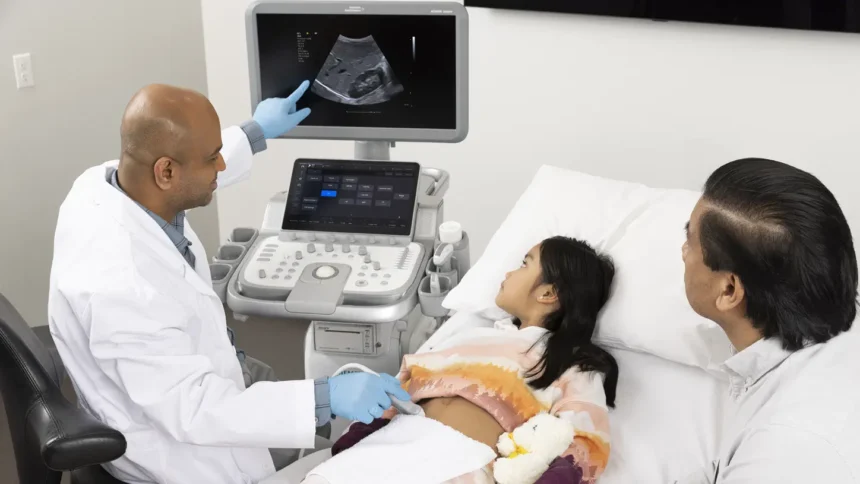When it comes to diagnosing medical conditions in children, safety and accuracy are top priorities. An ultrasound is one of the commonly used imaging tools for pediatric patients because it’s painless, radiation-free, and highly effective. Understanding how ultrasounds are used for pediatric patients helps parents learn what to expect during the procedure and how this technology supports early and accurate diagnosis, leading to better care.
How Does an Ultrasound Work?
An ultrasound examination uses high-frequency sound waves to create images of organs and other tissues inside the body. A small, handheld device called a transducer is placed on the skin, emitting sound waves that travel into the body. These waves bounce off internal structures and return to the transducer, which then sends the information to a computer. The computer translates these sound waves into a live image, which a sonographer can view on a monitor. The process provides a dynamic view of the body, enabling medical professionals to observe movement and function in real-time.
When Do Children Need One?
Ultrasound examinations in children are performed for various diagnostic purposes. Here is a list of frequent reasons why these non-invasive scans are utilized:
- Abdominal Pain or Discomfort: To evaluate issues such as appendicitis, constipation, or abdominal masses.
- Urinary Tract Concerns: To assess the kidneys, bladder, or signs of urinary tract infections.
- Suspected Congenital Abnormalities: To investigate structural abnormalities in organs.
- Soft Tissue Injuries or Lumps: To examine and differentiate between cysts, fluid collections, or other masses.
- Heart Conditions (via echocardiography): To monitor or diagnose potential heart defects or abnormalities.
Ultrasound is a versatile tool for these evaluations, often chosen due to its ability to provide real-time insights into a child’s condition.
What Should Parents Expect?
The ultrasound process is straightforward and generally painless, which is helpful when working with children. Before the examination begins, a clear, water-based gel is applied to the skin over the area being examined. This gel helps the sound waves travel effectively from the transducer into the body. The sonographer will then gently move the transducer across the skin while monitoring the images on the screen. The child will need to lie still during the scan to make sure the images are clear, and a parent can usually stay in the room to provide comfort and support. Once the scan is complete, the gel is wiped off, and the child can resume normal activities immediately.
Why Is It Key?
Ultrasound offers numerous benefits for pediatric care, making it a valuable diagnostic tool in various medical scenarios. Key benefits include:
- Non-invasive and Painless: Ultrasound does not require incisions or invasive procedures, providing a pain-free experience for children.
- Radiation-Free Imaging: Unlike other imaging techniques, ultrasound uses sound waves instead of ionizing radiation, reducing the risk of radiation exposure.
- Real-Time Results: The procedure enables real-time visualization, allowing healthcare providers to assess conditions instantly.
- Versatile Diagnostic Tool: Ultrasound can evaluate a wide range of conditions, from abdominal pain to heart abnormalities and soft tissue issues.
- Child-Friendly Approach: Due to its swift and gentle process, ultrasound minimizes discomfort for young patients.
These characteristics make ultrasound a highly effective and safe choice for diagnosing and monitoring pediatric conditions.
Book Your Ultrasound Appointment Today
Ultrasound is a safe, effective, and versatile medical imaging tool for diagnosing various conditions in pediatric patients. It provides clear, real-time images without the use of radiation, making it a reliable choice for children. If your child’s doctor has recommended an ultrasound, contact a medical imaging practice near you to book an appointment with a skilled provider today.





